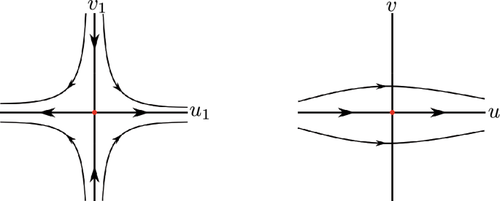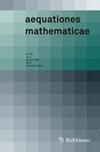立方体系统家族的全球中心
IF 0.9
3区 数学
Q2 MATHEMATICS
引用次数: 0
摘要
考虑平面 \(\mathbb {R}^2\) 中的 3 度多项式微分系统族,或者简单的立方系统 $$ x' = y, \quad y' = -x + a_1 x^2 + a_2 xy + a_3 y^2 + a_4 x^3 + a_5 x^2 y + a_6 xy^2 + a_7 y^3, $$。如果存在一个 \((x_0,y_0)\) 的邻域 \(\mathcal {U}\) 使得 \(\mathcal {U}\) 是一个中心,那么平面微分系统的平衡点 \((x_0,y_0)\) 就是一个中心。\充满了周期性的轨道。当 \(\mathbb {R}^2\setminus \{(x_0,y_0)\})充满了周期性轨道时,那么中心就是全局中心。劳埃德和皮尔逊(Comput Math Appl 60:2797-2805, 2010)在《计算数学应用 60:2797-2805,2010》一文中描述了这个立方系统家族中坐标原点为中心时的特征。我们对这些中心中哪些是全局中心进行了分类。本文章由计算机程序翻译,如有差异,请以英文原文为准。

Global centers of a family of cubic systems
Consider the family of polynomial differential systems of degree 3, or simply cubic systems
$$ x' = y, \quad y' = -x + a_1 x^2 + a_2 xy + a_3 y^2 + a_4 x^3 + a_5 x^2 y + a_6 xy^2 + a_7 y^3, $$
in the plane \(\mathbb {R}^2\). An equilibrium point \((x_0,y_0)\) of a planar differential system is a center if there is a neighborhood \(\mathcal {U}\) of \((x_0,y_0)\) such that \(\mathcal {U} \backslash \{(x_0,y_0)\}\) is filled with periodic orbits. When \(\mathbb {R}^2\setminus \{(x_0,y_0)\}\) is filled with periodic orbits, then the center is a global center. For this family of cubic systems Lloyd and Pearson characterized in Lloyd and Pearson (Comput Math Appl 60:2797–2805, 2010) when the origin of coordinates is a center. We classify which of these centers are global centers.
求助全文
通过发布文献求助,成功后即可免费获取论文全文。
去求助
来源期刊

Aequationes Mathematicae
MATHEMATICS, APPLIED-MATHEMATICS
CiteScore
1.70
自引率
12.50%
发文量
62
审稿时长
>12 weeks
期刊介绍:
aequationes mathematicae is an international journal of pure and applied mathematics, which emphasizes functional equations, dynamical systems, iteration theory, combinatorics, and geometry. The journal publishes research papers, reports of meetings, and bibliographies. High quality survey articles are an especially welcome feature. In addition, summaries of recent developments and research in the field are published rapidly.
 求助内容:
求助内容: 应助结果提醒方式:
应助结果提醒方式:


